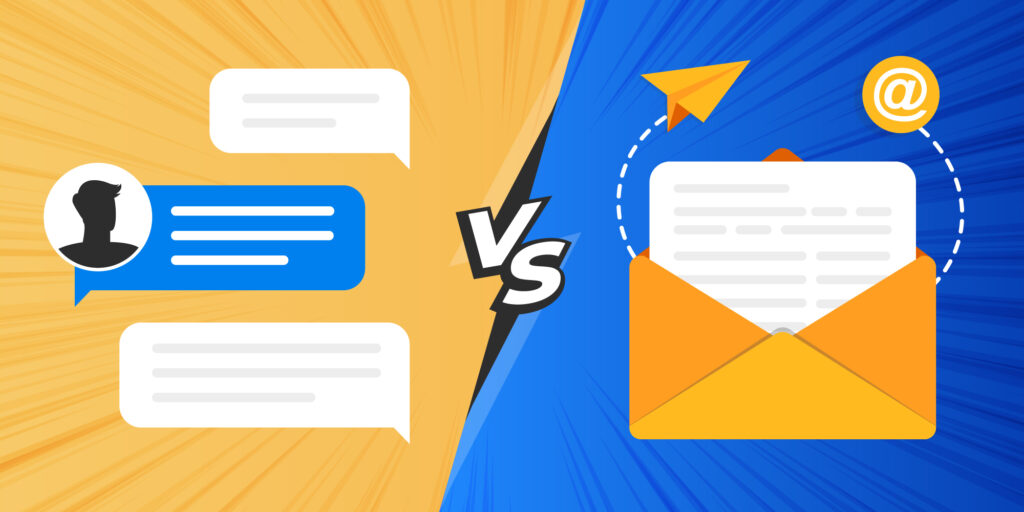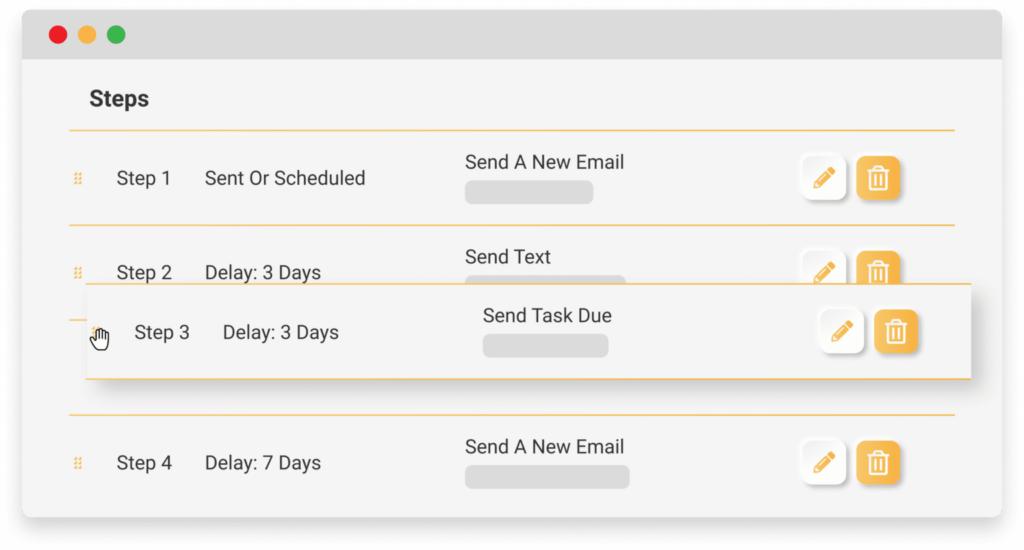Last updated on August 9th, 2023

Is email or text (also referred to as SMS) best for sales and marketing? The answer will be in the details of your specific business.
There is no one-size-fits-all answer. The best channel will depend on your specific use case and audience.
We’ve been using email for business since the 1980s, and although it’s changing, it’s not fading out as an effective business communication channel anytime soon.
On the other hand, commercial SMS services have been on the rise, allowing businesses to reach customers where they spend a huge portion of their time: their smartphones.
This guide will cover:
- Is Texting Or Email Better For Business?
- Why Do We Use Texting And Email In Business?
- Who Should Use Texting Or Email?
- Pros And Cons Of Texting Vs. Email
- Email Vs. Text By Use Case
- How To Use Email And Texting In Your Business
- What Software To Use For Email And Texting?

VipeCloud is the only Automation tool your small business needs to
be the hero to your customers.
With Email, Texting, Social, Suites, Chat, Stories, Video Email & Sign Up Forms fully built-in, we provide you with the perfect platform to grow your business.
15 Day Free Trial – Get started risk free. No CC needed.
Is Texting Or Email Better For Business?
Unlike other sources that may give you biased answers based on whatever they’re selling, we admit there’s no cut-and-dry answer for whether email or text is better for business.
Both channels have their place in business today.
While using email is tried and true, SMS text messaging has its place for being an effective way to communicate with customers.
Sometimes one channel may be better than the other for a specific audience with a specific use case.
So below, we’ll get as specific as possible on whether SMS or email is best for you based on unique scenarios.
Spoiler alert: You should probably be doing both. So we’ll also give you tips on how to apply both in your business.
Why Do We Use Texting And Email In Business?
You already know the most successful companies today use email and texting in their sales process and marketing strategies.
But what do the stats say?
Let’s take a look:

- 4.371 billion people use email worldwide (2023).
- 60% of consumers prefer promotions via email
- 49% of consumers want promotions sent to their email from their favorite brands.
- 61.9% of all emails opened are from a mobile device.
- The average email marketing ROI is $42 earned for every $1 spent.
- 65% of email users check their email 3X per day.
- Email usage by age demographic:
- Ages 15-24 — 90%
- Ages 25-44 — 93.6%
- Ages 45-64 — 90.1%
- Ages 65+ — 84.1%
Texting
- There are 6.899 billion mobile network subscriptions in the world (2023).
- 91% of consumers say they want to opt-in to receive promotions via text.
- Americans check their smartphones 47 times per day.
- The average open rate for SMS campaigns is 98%
- 97% of Americans have a smartphone.
- 89% of phone users open text messages within 30 minutes of receiving it.
- Over 90% of people ages 50-70+ use text messaging.
Who Should Use Texting Or Email?
Your goal should be to meet your target audience where they’re already at.
So if they live in their email inbox, email is a great communication channel.
However, if they’re sending text messages and are on their smartphone all day, texting is probably a better option.
Which channel your audience uses might also differ based on your industry and their preferences.
Below, you’ll find open rates for email marketing by industry:
| Government | 28.77% |
| Hobbies | 27.74% |
| Religion | 27.62% |
| Arts and Artists | 26.27% |
| Non-Profit | 25.17% |
| Sports | 24.57% |
| Education and Training | 23.42% |
| Agriculture and Food Services | 23.31% |
| Photo and Video | 23.24% |
| Politics | 22.94% |
| All non-labeled accounts | 22.71% |
| Architecture and Construction | 22.51% |
| Media and Publishing | 22.15% |
| Legal | 22.00% |
| Professional Services | 21.94% |
| Music and Musicians | 21.88% |
| Construction | 21.77% |
| Medical, Dental, and Healthcare | 21.72% |
| Gambling | 21.62% |
| Home and Garden | 21.60% |
| Business and Finance | 21.56% |
| Health and Fitness | 21.48% |
| Creative Services/Agency | 21.39% |
| Insurance | 21.36% |
| Software and Web App | 21.29% |
| Recruitment and Staffing | 21.14% |
| Games | 21.10% |
| Social Networks and Online Communities | 21.06% |
| Public Relations | 21.02% |
| Telecommunications | 20.92% |
| Entertainment and Events | 20.51% |
| Travel and Transportation | 20.44% |
| Restaurant and Venue | 20.39% |
| Consulting | 20.13% |
| Manufacturing | 19.82% |
| Restaurant | 19.77% |
| Computers and Electronics | 19.29% |
| Mobile | 19.29% |
| Real Estate | 19.17% |
| Pharmaceuticals | 18.58% |
| Retail | 18.39% |
| Marketing and Advertising | 17.38% |
| Beauty and Personal Care | 16.65% |
| E-Commerce | 15.68% |
| Daily Deals/E-Coupons | 15.06% |
| Vitamin Supplements | 15.03% |
The higher the open rate for your industry, the easier it’ll be for you to reach your customers.
However, these statistics might not be exactly reflective of your industry and business, so you need to do more research into your specific audience.
How?
Here are 2 ways to test if you should focus more on email:
- Survey your customers:
- Where do they want to receive promotions?
- How would they prefer for you to reach them?
- Send some email campaigns. Are you getting better or worse results than your industry’s benchmark open rates?
Texting
Certain industries use email more than others, but most people use texting in some capacity.
97% of Americans use smartphones, and 91% of consumers would opt-in to receive promotions via text.
Even over 90% of baby boomers are using text messaging for communication.
Because of this, your customers and audience will likely resonate with SMS too.
But to be sure, consider surveying your customers about where they want to receive promotions and how they’d like you to message them.
Also, test using SMS in your business. SMS platforms have gotten affordable enough for just about anyone to try it out.
Pros And Cons Of Texting Vs. Email
Each channel has its pros and cons, but that doesn’t necessarily mean that one is better than the other.
As we compare the pros and cons of each channel, consider the importance of each as it relates to your business.
Pros:
- Formal and professional – Emails are typically considered more formal than text messages, making them ideal for important business communications.
- Information density – Emails allow you to include a lot of information (attachments, links, etc.). This can be useful when conveying complex or detailed information.
- Traceability – Emails are easy to track, search, and archive, providing a traceable history of communications.
- Easy to reach your audience – Nearly everyone has an email address, and many professionals check their email multiple times a day.
- Formatting options – Emails offer formatting options (bold, italics, bullet points, color, embedded images, etc.) to make messages clearer and more engaging.
- No character limit – Unlike text messages, emails don’t have a character limit, allowing you to write as much as needed.
Cons:
- Low response rates – Emails often have lower open and response rates than text messages.
- Spam – Emails can be easily marked as spam or get lost in a cluttered inbox, reducing their effectiveness. Prospects also have mental spam filters because of how saturated email marketing has become.
- Slow responses – Respondents usually don’t reply immediately.
- Oversaturated – With the large number of emails people receive daily, your message can easily be overlooked or ignored.
Texting
Pros:
- High open rates – Text messages get about 98% open rates because they often trigger notifications on the recipient’s phone.
- Immediate – Text messages are usually read and responded to quickly, often within minutes of receipt.
- Personal – Text messages can feel more personal than emails, helping build stronger customer relationships.
- Convenience – Text messages can be read and responded to on the go, making it easy for busy professionals to stay in touch.
- Effective for short messages – Texts are perfect for brief, direct communications like reminders or notifications.
Cons:
- Informality – Text messages can be seen as less professional than emails, which may not be suitable for certain business communications. In other words, if you text someone who didn’t opt-in, they might get upset.
- Limited content options – Texts have character limits and lack the ability to include attachments or formatted text.
- Intrusiveness – Text messages can be seen as more intrusive than emails, especially if sent outside of working hours.
- Difficulty in tracking – Unlike emails, tracking conversations and storing information can be challenging with text messages.
- Accessibility – Not everyone prefers or is comfortable with texting, and international text messaging can be complicated and costly.
Email Vs. Text By Use Case
So when is the best time to use email or texting in your business?
Certain actions or campaigns are better suited for email or text than others. And some might be effective via either channel.
Here’s a list of best-suited use cases for each:
10 Email Use Cases
- Outreach – Reach out to leads in your industry with relevant pitches to book sales appointments.
- Product launches – Announce new products or services, providing detailed information, images, and even video content.
- Newsletters – Newsletters offer the chance to engage with customers and share industry news, tips, blog posts, and updates about your business.
- Sales promotions – Send discount codes, promotional offers, and sales alerts to customers.
- Customer service – Handle customer queries, complaints, and feedback in a formal manner. Emails allow for a thorough response and are documented.
- Internal communication – Use email for internal communication, sharing important announcements, meeting invites, or policy changes with employees.
- Sales follow-up – Send summaries of your previous interactions, pains, goals, and action items after sales calls with prospects. Also, easily send sales content by attaching it to the email.
- Re-engagement campaigns – Win back inactive customers by providing special offers, updates, or personalized messages.
- Lead nurturing – Emails can be used for drip campaigns to nurture leads, providing relevant content over time to help move prospects through the sales funnel.
- Sending proposals and quotes – For detailed proposals or quotes, email is the best method due to its ability to handle complexity and attachments.
9 Texting Use Cases
- Appointment reminders – Send text message reminders for appointments, reservations, or events.
- Quick follow-ups – After an initial call or meeting, send a brief text to confirm details, show appreciation for their time, or nudge a response from a previously sent email.
- Status updates – If a customer is waiting for an update on a particular issue or order, a quick text can keep them informed and engaged.
- Delivery updates – E-commerce businesses can use texts to update customers about their order status and delivery details.
- Promotions – A quick text can alert customers to act fast for limited-time offers or flash sales.
- Personalized messages to customers – Texts can be used to send birthday greetings or personalized messages to build relationships with customers.
- Customer support – For quick queries, a text message to customer support can be faster and more convenient than an email.
- Surveys and feedback – Text messages can be used to collect customer feedback or reviews via short surveys.
- SMS contests – Texts can be a convenient medium for running contests or sweepstakes, encouraging customers to participate by simply replying to the message.
How To Use Email And Texting In Your Business
The top industry leaders use email and text messaging together in their sales and marketing.
We recommend making use of as many of the use cases as possible that we mentioned above.
That way, you reach your audience at the right time and on their preferred platform.
So how do you syncronize the 2 channels?
By building a cross-channel customer journey using automated workflows and sequences.
Here’s an example of what that might look like:
- Use a sign-up form to collect email and phone numbers from a landing page.
- Send a weekly or monthly newsletter via email to nurture your audience over time.
- Send a link to a survey via SMS to collect data on your audience’s pain points.
- Based on your audience’s pain points, segment your contact list.
- Create an email nurture sequence educating your audience on their pain points and actionable solutions over the course of 7 days.
- Send an offer to your audience that’s relevant to their pain points via email and text. Include a CTA for them to reply to book a free consultation or demo.
- Send SMS reminders for any sales appointments you book.
- After the sales appointment, send an email follow-up.
- If they’re ready to buy after a sales meeting, email them a quote and proposal.
- After they buy, keep them up-to-date with service delivery via email or text.
- Use text and email for customer support to educate them on how to use or resolve any issues around your product or service.
- After they become a happy customer, send them new offers via email and text to cross-sell or upsell and increase your CLV (customer lifetime value).
- Repeat.
What’s The Best Software For Texting And Email?
If that example of an email and text customer journey sounds like a ton of manual work (and remembering), you’d be right.
Which is why you should use a platform for SMS and email to have a unified customer experience.
With CRM (customer relationship management) software like VipeCloud, you can turn that very manual process into an automated sales funnel that looks more like this:

The best part? You don’t have to do it alone when you choose VipeCloud.
VipeCloud’s customers rave about our attentive and caring customer support.

If you’re ready to start growing your business with email and texting, you have 2 easy options to get started:
- Sign-up for a free 15-day free trial (no credit card required).
- Request a demo with our team. We’ll be happy to show you how VipeCloud can help grow your business.
Frequently Asked Questions About Email Vs. Texting
Is Email More Professional Than Texting?
Traditionally, email has been viewed as more professional than texting. This is mainly because emails allow for more formality, a clear subject line, and company branding.
Additionally, emails allow for comprehensive archiving and record-keeping.
However, as business communication evolves, texting has become accepted for brief, immediate communication in professional contexts.
Should You Email Or Text Sensitive Information?
Neither email nor text messages are completely secure channels and, thus, should not be used to send sensitive information such as credit card details, social security numbers, or confidential business data.
If you must send sensitive information, using encrypted email services or secure business communication platforms that provide end-to-end encryption is best.
Which Is Better For Sales Promotions, Email or Texting?
Both channels can be effective for sales promotions, depending on your target audience and the nature of the promotion. Email allows for detailed promotion descriptions, images, and links, so they’re particularly effective for complex offers.
On the other hand, text messages are great for immediate, short-term promotions due to their high open rates and immediacy.
What’s The Best Way To Integrate Email And Texting In My Marketing Strategy?
The best approach is to use each channel to its strengths and based on your customers’ preferences. Ensure that your messaging is consistent across both channels.
Email is excellent for sending detailed content, such as newsletters, product information, and educational content.
Texting can be used for timely reminders, brief updates, and short-term promotions.
Are There Legal Regulations For Business Texting And Emailing?
Yes, both business texting and emailing are governed by regulations.
For example, in the US, the CAN-SPAM Act regulates commercial emails, while the Telephone Consumer Protection Act (TCPA) oversees business text messages.
In Europe, the General Data Protection Regulation (GDPR) provides guidelines for both.
It’s crucial to understand and abide by these regulations, which typically involve getting recipient consent, providing opt-out options, and respecting user data privacy.

This blog provides a concise and informative comparison between email and SMS. This is a valuable resource for those navigating the digital media landscape. Understanding when to use each method is important in today’s fast-paced world.
Thank you for providing this information; it was extremely useful.